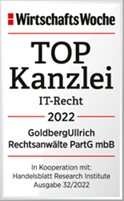The legislator has passed comprehensive amendments to the Price Indication Ordinance (PAngV). Due to the change in the law, extensive changes to your price quotations will be necessary. In the following, we will show you the most important changes that are coming your way:
Indication of the basic price
What is new is that the obligation to indicate the basic price is now regulated in the new § 4 PAngV. The regulation has been reworded and now clarifies that price information must be indicated "unambiguously, clearly recognisable and legible", but no longer necessarily in the immediate vicinity of the total price.
Units of measure apply to the indication of the basic price
On the basis of a new resolution of the Bundesrat (Federal Council), Section 5 (1) PAngV stipulates that for the purpose of better price transparency, "1 kilogram, 1 litre, 1 cubic metre, 1 metre or one square metre" is to be used uniformly as the unit of measure for the indication of basic prices. The previous possibility of a deviation for goods whose nominal weight or nominal volume does not usually exceed 250 grams or 250 millilitres is deleted without replacement. For goods which are usually indicated in quantities of 100 litres and more, 50 kilograms and more or 100 metres and more, the unit of quantity which corresponds to the general perception of the trade shall be used for the basic price.
This change makes it necessary to recast all price indications for goods that contain basic price indications by weight or quantity!
Deposit amount disclosure
The new regulations also include far-reaching changes in the reporting of deposit amounts. This question has repeatedly occupied the courts. § Section 7 PAngV n.F. now contains a clear regulation on this under the heading "Refundable security". According to this, the amount of the deposit must be stated next to the total price and not included in it.
New regulations for price reductions
The amendments to the Price Indication Ordinance include new regulations concerning price indications in the case of price reductions. The main aim is to make it easier for consumers to understand price reductions for goods in the future. Among other things, it is to be prevented that, when announcing price reductions, reference is made to previous prices without these having been requested beforehand. Thus, from May 2022, each announcement of a price reduction must indicate the previous price applied by the trader over a certain period of time before the price reduction. The previous price is the lowest price applied by the trader within a period of at least 30 days before the application of the price reduction (Section 11 PAngV n.F.).
Prices for spot charging of electrically powered vehicles
The new Price Indication Ordinance contains a new regulation in § 14 para. 2 PAngV n.F. According to this, operators of "publicly accessible charging points" that enable consumers to "recharge electric vehicles at certain points" must indicate the "energy price per kilowatt hour" at the respective charging point and enable a "call-up option for a display of the price on the display of a mobile end device".
When does the new Price Indication Regulation come into force?
The amended Price Indication Regulation will enter into force on 28 May 2022 in accordance with the requirements of Directive 2019/2161/EU. The currently applicable Price Indication Regulation will then cease to apply at the same time.
What does this mean for your company?
The new version of the Price Indication Ordinance makes it urgently necessary to review and, if necessary, revise your price indications for all goods. This applies in particular to price quotations in online shops. This is because a large number of warnings under competition law are issued due to violations of the Price Indication Ordinance. These expensive warnings are absolutely avoidable - we show you what you need to consider in your price quotations and help you to comply with the strict requirements of the Price Indication Ordinance.
GoldbergUllrich Rechtsanwälte PartG mbB 2021
Christopher Pillat, LL.M. (Intellectual Property Law)
Lawyer


